seats TOYOTA GR YARIS 2022 Owners Manual
[x] Cancel search | Manufacturer: TOYOTA, Model Year: 2022, Model line: GR YARIS, Model: TOYOTA GR YARIS 2022Pages: 470, PDF Size: 113.17 MB
Page 3 of 470
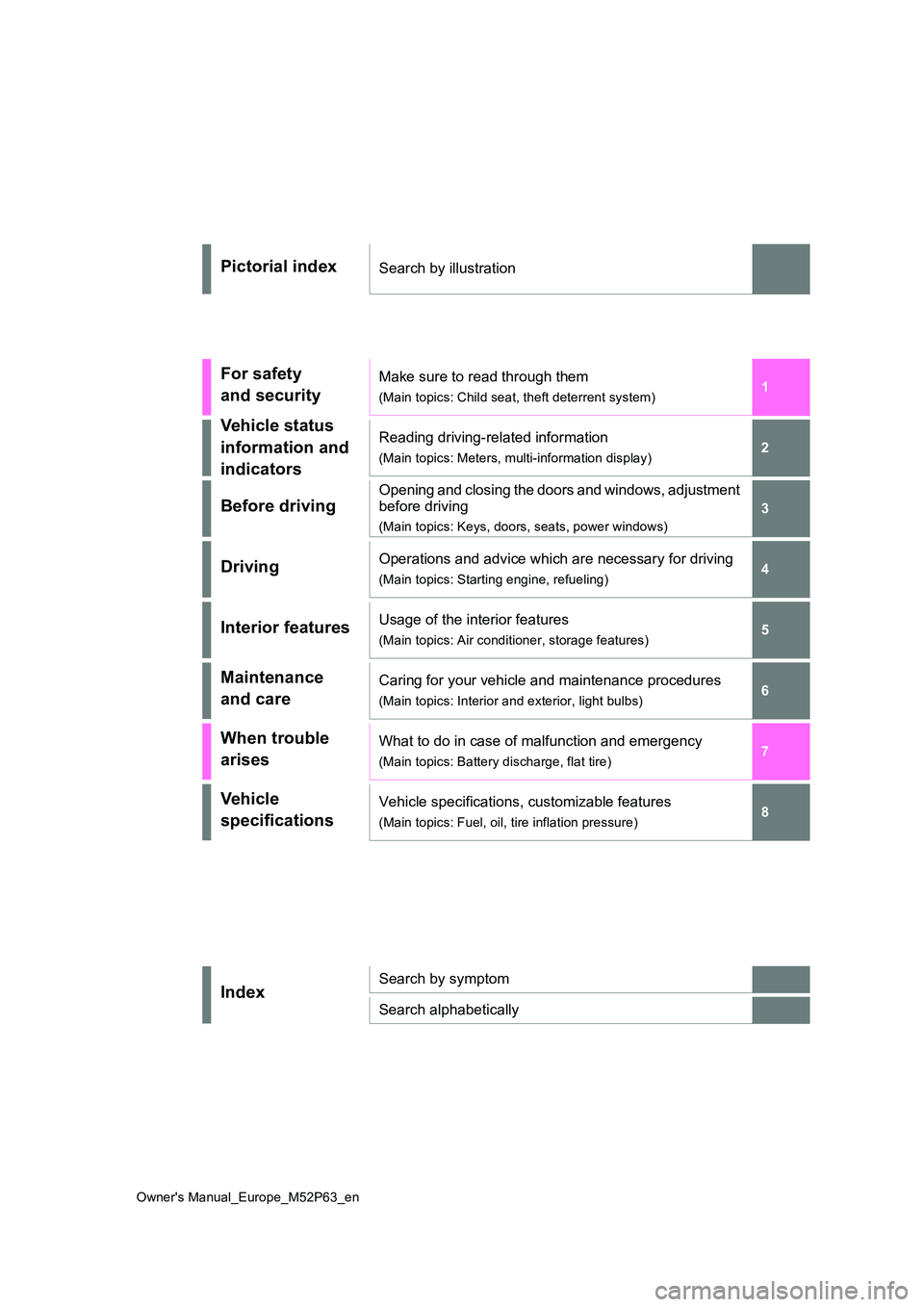
1
6
5
4
3
2
7
8
Owner's Manual_Europe_M52P63_en
Pictorial indexSearch by illustration
For safety
and security
Make sure to read through them
(Main topics: Child seat, theft deterrent system)
Vehicle status
information and
indicators
Reading driving-related information
(Main topics: Meters, multi-information display)
Before driving
Opening and closing the doors and windows, adjustment
before driving
(Main topics: Keys, doors, seats, power windows)
DrivingOperations and advice which are necessary for driving
(Main topics: Starting engine, refueling)
Interior featuresUsage of the interior features
(Main topics: Air conditioner, storage features)
Maintenance
and care
Caring for your vehicle and maintenance procedures
(Main topics: Interior and exterior, light bulbs)
When trouble
arises
What to do in case of malfunction and emergency
(Main topics: Battery discharge, flat tire)
Vehicle
specifications
Vehicle specifications, customizable features
(Main topics: Fuel, oil, tire inflation pressure)
IndexSearch by symptom
Search alphabetically
Page 4 of 470
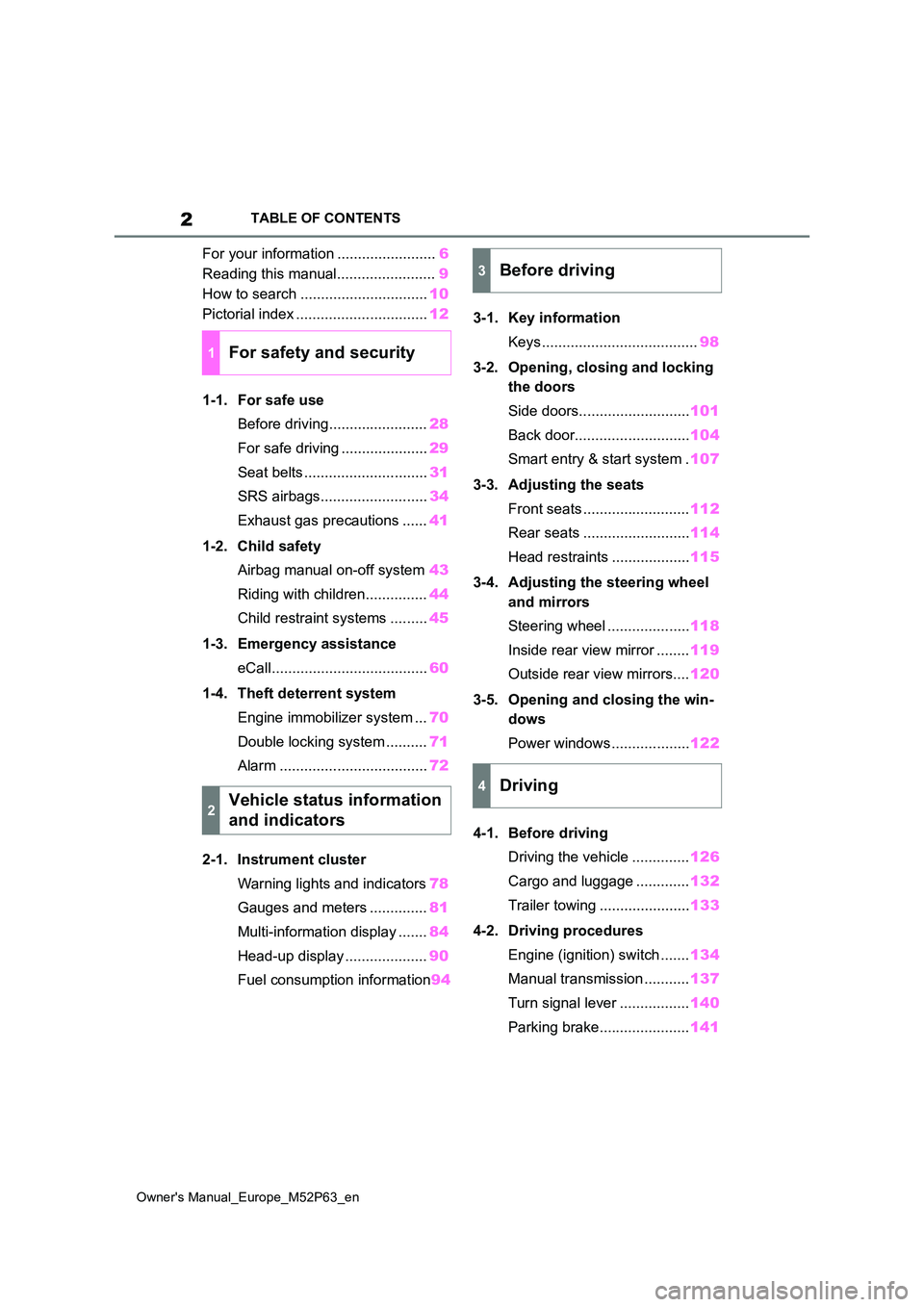
2
Owner's Manual_Europe_M52P63_en
TABLE OF CONTENTS
For your information ........................6
Reading this manual........................ 9
How to search ............................... 10
Pictorial index ................................ 12
1-1. For safe use
Before driving........................ 28
For safe driving ..................... 29
Seat belts .............................. 31
SRS airbags.......................... 34
Exhaust gas precautions ...... 41
1-2. Child safety
Airbag manual on-off system 43
Riding with children............... 44
Child restraint systems ......... 45
1-3. Emergency assistance
eCall...................................... 60
1-4. Theft deterrent system
Engine immobilizer system ... 70
Double locking system .......... 71
Alarm .................................... 72
2-1. Instrument cluster
Warning lights and indicators 78
Gauges and meters .............. 81
Multi-information display ....... 84
Head-up display .................... 90
Fuel consumption information 94
3-1. Key information
Keys ...................................... 98
3-2. Opening, closing and locking
the doors
Side doors........................... 101
Back door............................ 104
Smart entry & start system . 107
3-3. Adjusting the seats
Front seats .......................... 112
Rear seats .......................... 114
Head restraints ................... 115
3-4. Adjusting the steering wheel
and mirrors
Steering wheel .................... 118
Inside rear view mirror ........ 119
Outside rear view mirrors.... 120
3-5. Opening and closing the win-
dows
Power windows ................... 122
4-1. Before driving
Driving the vehicle .............. 126
Cargo and luggage ............. 132
Trailer towing ...................... 133
4-2. Driving procedures
Engine (ignition) switch ....... 134
Manual transmission ........... 137
Turn signal lever ................. 140
Parking brake...................... 141
1For safety and security
2Vehicle status information
and indicators
3Before driving
4Driving
Page 20 of 470
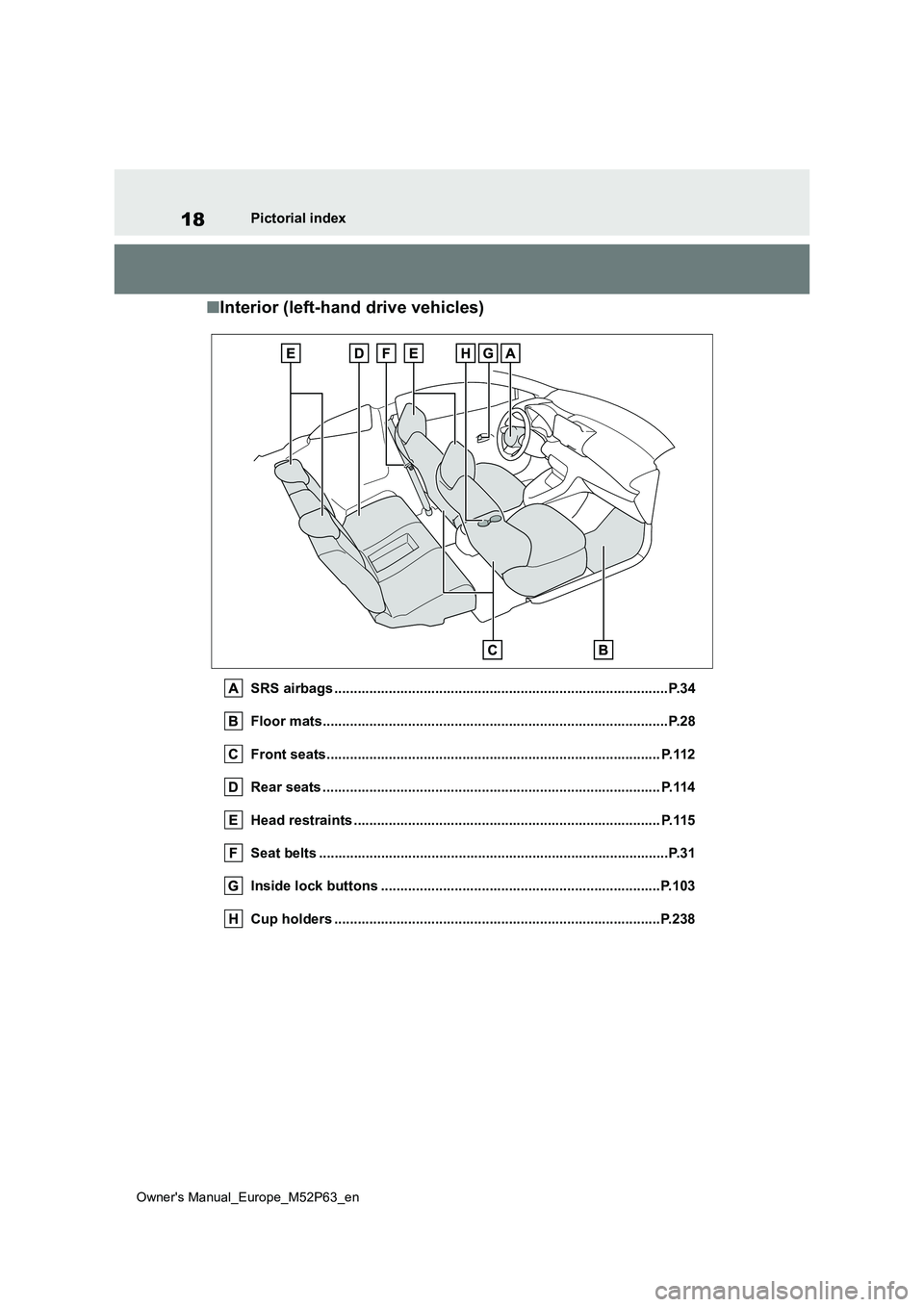
18
Owner's Manual_Europe_M52P63_en
Pictorial index
■Interior (left-hand drive vehicles)
SRS airbags ......................................................................................P.34
Floor mats..................................................... ....................................P.28
Front seats.................................................... .................................. P.112
Rear seats ..................................................... .................................. P.114
Head restraints ................................................ ............................... P.115
Seat belts ..................................................... .....................................P.31
Inside lock buttons ............................................ ............................P.103
Cup holders .................................................... ................................P.238
Page 26 of 470

24
Owner's Manual_Europe_M52P63_en
Pictorial index
■Interior (right-hand drive vehicles)
SRS airbags ......................................................................................P.34
Floor mats..................................................... ....................................P.28
Front seats.................................................... .................................. P.112
Rear seats ..................................................... .................................. P.114
Head restraints ................................................ ............................... P.115
Seat belts ..................................................... .....................................P.31
Inside lock buttons ............................................ ............................P.103
Cup holders .................................................... ................................P.238
Page 32 of 470

30
Owner's Manual_Europe_M52P63_en
1-1. For safe use
Make sure that all occupants are
wearing their seat belts before driv-
ing the vehicle. ( P.31)
Use a child restraint system appro-
priate for the child until the child
becomes large enough to properly
wear the vehicle’s seat belt.
( P. 4 5 )
Make sure that you can see back-
ward clearly by adjusting the inside
and outside rear view mirrors prop-
erly. ( P.119, 120)
WARNING
■For safe driving
Observe the following precautions.
Failure to do so may result in death or serious injury.
●Do not adjust the position of the driver’s seat while driving.Doing so could cause the driver to
lose control of the vehicle.
●Do n ot p la ce a cu s hi on b et we en t he
driver or passenger and the seatback.A cushion may prevent correct pos-
ture from being achieved, and reduce the effectiveness of the seat belt and head restraint.
●Do not place anything under the front seats.
Objects placed under the front seats may become jammed in the seat tracks and stop the seat from
locking in place. This may lead to an accident and the adjustment mechanism may also be damaged.
●Always observe the legal speed limit when driving on public roads.
●When driving over long distances, take regular breaks before you start
to feel tired. Also, if you feel tired or sleepy while driving, do not force yourself to con-
tinue driving and take a break immediately.
Correct use of the seat belts
Adjusting the mirrors
Page 33 of 470
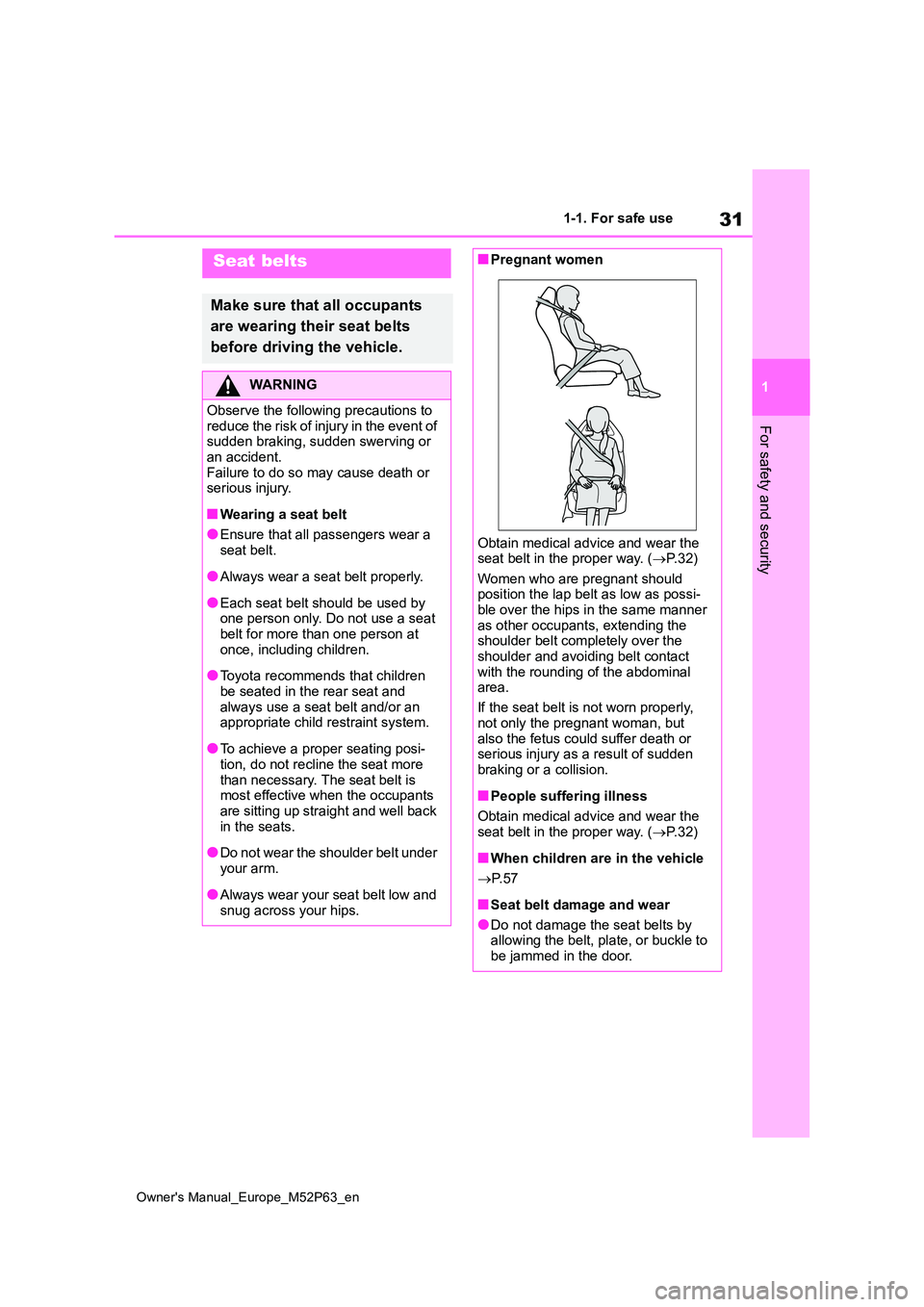
31
1
Owner's Manual_Europe_M52P63_en
1-1. For safe use
For safety and security
Seat belts
Make sure that all occupants
are wearing their seat belts
before driving the vehicle.
WARNING
Observe the following precautions to
reduce the risk of injury in the event of sudden braking, sudden swerving or an accident.
Failure to do so may cause death or serious injury.
■Wearing a seat belt
●Ensure that all passengers wear a seat belt.
●Always wear a seat belt properly.
●Each seat belt should be used by one person only. Do not use a seat belt for more than one person at
once, including children.
●Toyota recommends that children
be seated in the rear seat and always use a seat belt and/or an appropriate child restraint system.
●To achieve a proper seating posi-tion, do not recline the seat more
than necessary. The seat belt is most effective when the occupants are sitting up straight and well back
in the seats.
●Do not wear the shoulder belt under
your arm.
●Always wear your seat belt low and
snug across your hips.
■Pregnant women
Obtain medical advice and wear the seat belt in the proper way. ( P. 3 2 )
Women who are pregnant should position the lap belt as low as possi-ble over the hips in the same manner
as other occupants, extending the shoulder belt completely over the shoulder and avoiding belt contact
with the rounding of the abdominal area.
If the seat belt is not worn properly,
not only the pregnant woman, but also the fetus could suffer death or serious injury as a result of sudden
braking or a collision.
■People suffering illness
Obtain medical advice and wear the seat belt in the proper way. ( P. 3 2 )
■When children are in the vehicle
P. 5 7
■Seat belt damage and wear
●Do not damage the seat belts by allowing the belt, plate, or buckle to
be jammed in the door.
Page 35 of 470
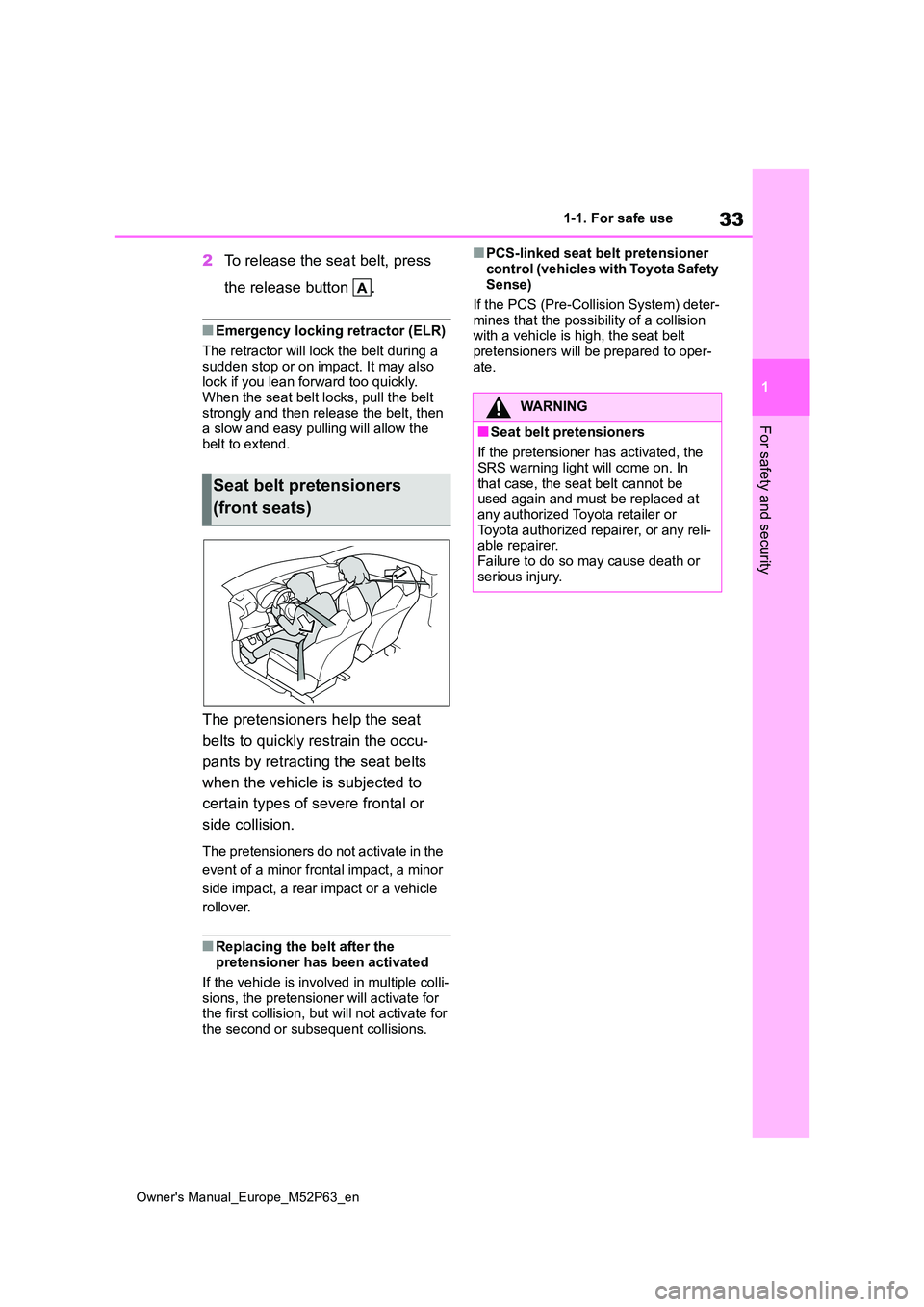
33
1
Owner's Manual_Europe_M52P63_en
1-1. For safe use
For safety and security
2To release the seat belt, press
the release button .
■Emergency locking retractor (ELR)
The retractor will lock the belt during a sudden stop or on impact. It may also lock if you lean forward too quickly.
When the seat belt locks, pull the belt strongly and then release the belt, then a slow and easy pulling will allow the
belt to extend.
The pretensioners help the seat
belts to quickly restrain the occu-
pants by retracting the seat belts
when the vehicle is subjected to
certain types of severe frontal or
side collision.
The pretensioners do not activate in the
event of a minor frontal impact, a minor
side impact, a rear impact or a vehicle
rollover.
■Replacing the belt after the pretensioner has been activated
If the vehicle is involved in multiple colli-
sions, the pretensioner will activate for the first collision, but will not activate for the second or subsequent collisions.
■PCS-linked seat belt pretensioner
control (vehicles with Toyota Safety Sense)
If the PCS (Pre-Collision System) deter-
mines that the possibility of a collision with a vehicle is high, the seat belt pretensioners will be prepared to oper-
ate.
Seat belt pretensioners
(front seats)
WARNING
■Seat belt pretensioners
If the pretensioner has activated, the
SRS warning light will come on. In that case, the seat belt cannot be used again and must be replaced at
any authorized Toyota retailer or Toyota authorized repairer, or any reli-able repairer.
Failure to do so may cause death or serious injury.
Page 38 of 470
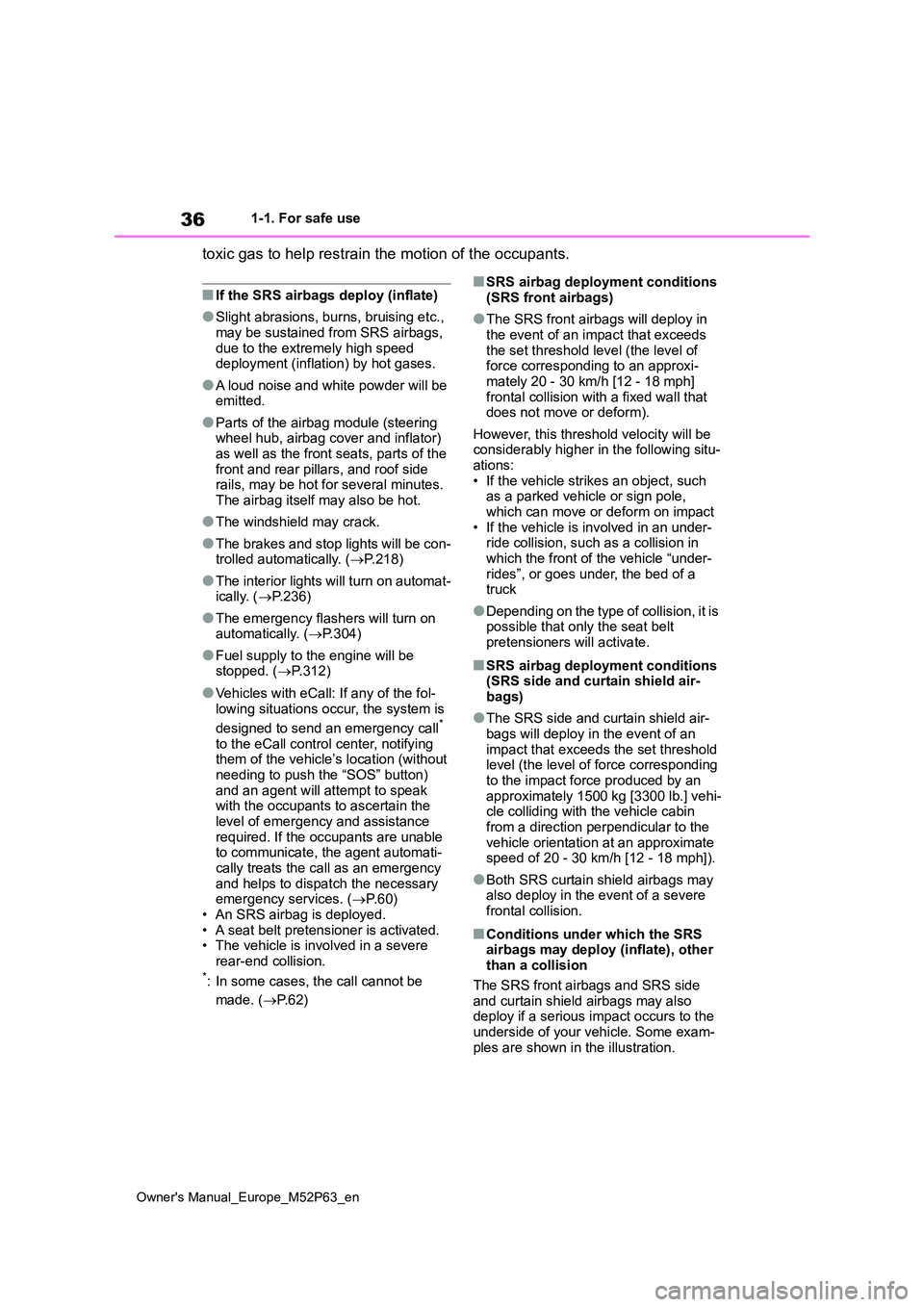
36
Owner's Manual_Europe_M52P63_en
1-1. For safe use
toxic gas to help restrain the motion of the occupants.
■If the SRS airbags deploy (inflate)
●Slight abrasions, burns, bruising etc., may be sustained from SRS airbags,
due to the extremely high speed deployment (inflation) by hot gases.
●A loud noise and white powder will be emitted.
●Parts of the airbag module (steering wheel hub, airbag cover and inflator) as well as the front seats, parts of the
front and rear pillars, and roof side rails, may be hot for several minutes. The airbag itself may also be hot.
●The windshield may crack.
●The brakes and stop lights will be con-trolled automatically. ( P.218)
●The interior lights will turn on automat- ically. ( P.236)
●The emergency flashers will turn on automatically. ( P.304)
●Fuel supply to the engine will be stopped. ( P.312)
●Vehicles with eCall: If any of the fol-
lowing situations occur, the system is
designed to send an emergency call*
to the eCall control center, notifying them of the vehicle’s location (without needing to push the “SOS” button)
and an agent will attempt to speak with the occupants to ascertain the
level of emergency and assistance required. If the occupants are unable to communicate, the agent automati-
cally treats the call as an emergency and helps to dispatch the necessary emergency services. ( P.60)
• An SRS airbag is deployed. • A seat belt pretensioner is activated.• The vehicle is involved in a severe
rear-end collision.*: In some cases, the call cannot be
made. ( P. 6 2 )
■SRS airbag deployment conditions
(SRS front airbags)
●The SRS front airbags will deploy in
the event of an impact that exceeds the set threshold level (the level of force corresponding to an approxi-
mately 20 - 30 km/h [12 - 18 mph] frontal collision with a fixed wall that does not move or deform).
However, this threshold velocity will be considerably higher in the following situ-
ations: • If the vehicle strikes an object, such as a parked vehicle or sign pole,
which can move or deform on impact • If the vehicle is involved in an under-ride collision, such as a collision in
which the front of the vehicle “under- rides”, or goes under, the bed of a truck
●Depending on the type of collision, it is possible that only the seat belt
pretensioners will activate.
■SRS airbag deployment conditions (SRS side and curtain shield air-bags)
●The SRS side and curtain shield air-bags will deploy in the event of an
impact that exceeds the set threshold level (the level of force corresponding to the impact force produced by an
approximately 1500 kg [3300 lb.] vehi- cle colliding with the vehicle cabin from a direction perpendicular to the
vehicle orientation at an approximate speed of 20 - 30 km/h [12 - 18 mph]).
●Both SRS curtain shield airbags may also deploy in the event of a severe frontal collision.
■Conditions under which the SRS airbags may deploy (inflate), other than a collision
The SRS front airbags and SRS side and curtain shield airbags may also deploy if a serious impact occurs to the
underside of your vehicle. Some exam- ples are shown in the illustration.
Page 40 of 470
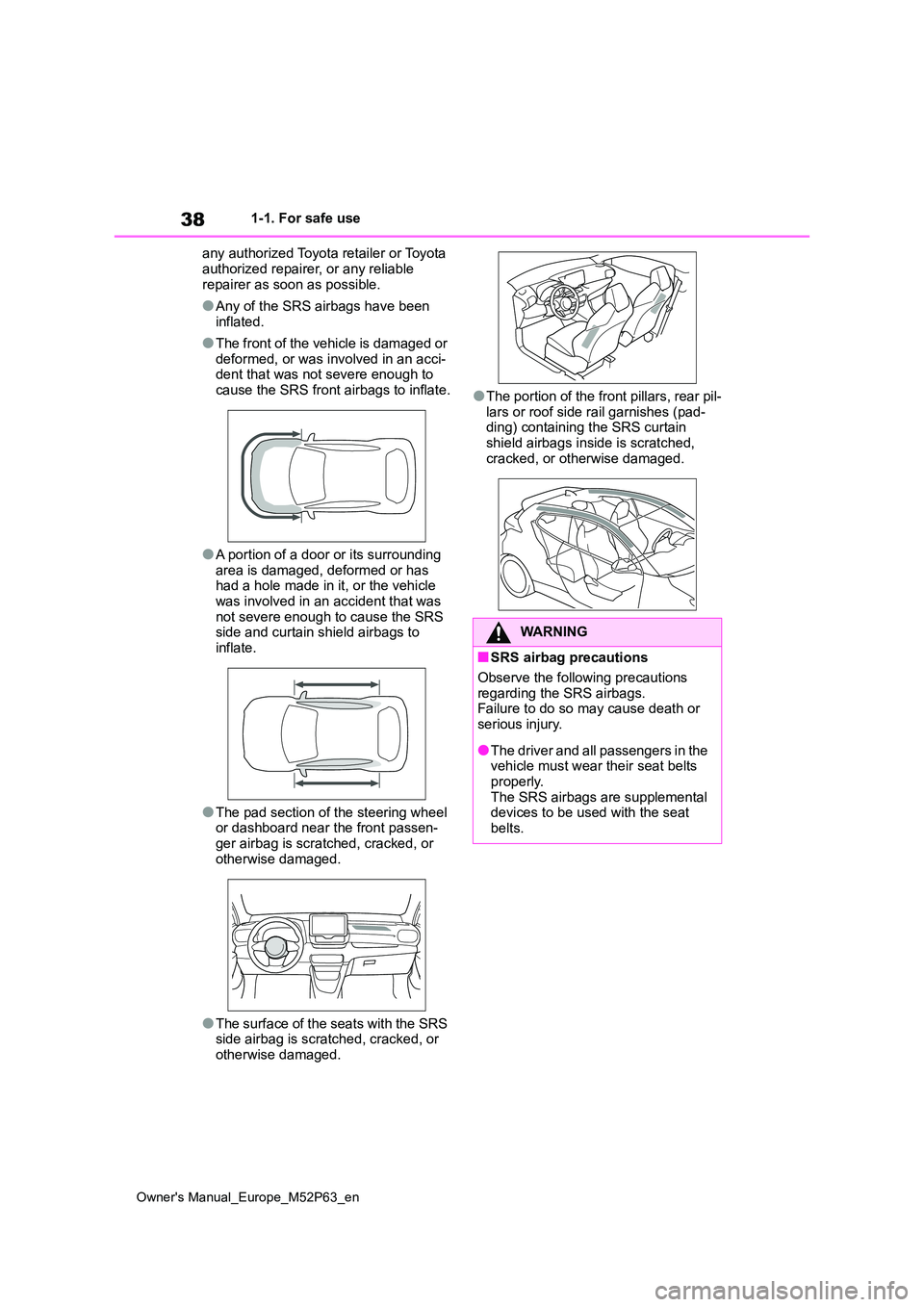
38
Owner's Manual_Europe_M52P63_en
1-1. For safe use
any authorized Toyota retailer or Toyota
authorized repairer, or any reliable repairer as soon as possible.
●Any of the SRS airbags have been inflated.
●The front of the vehicle is damaged or deformed, or was involved in an acci-dent that was not severe enough to
cause the SRS front airbags to inflate.
●A portion of a door or its surrounding
area is damaged, deformed or has had a hole made in it, or the vehicle was involved in an accident that was
not severe enough to cause the SRS side and curtain shield airbags to inflate.
●The pad section of the steering wheel or dashboard near the front passen-
ger airbag is scratched, cracked, or otherwise damaged.
●The surface of the seats with the SRS side airbag is scratched, cracked, or otherwise damaged.
●The portion of the front pillars, rear pil-
lars or roof side rail garnishes (pad- ding) containing the SRS curtain shield airbags inside is scratched,
cracked, or otherwise damaged.
WARNING
■SRS airbag precautions
Observe the following precautions
regarding the SRS airbags. Failure to do so may cause death or serious injury.
●The driver and all passengers in the vehicle must wear their seat belts
properly. The SRS airbags are supplemental devices to be used with the seat
belts.
Page 41 of 470
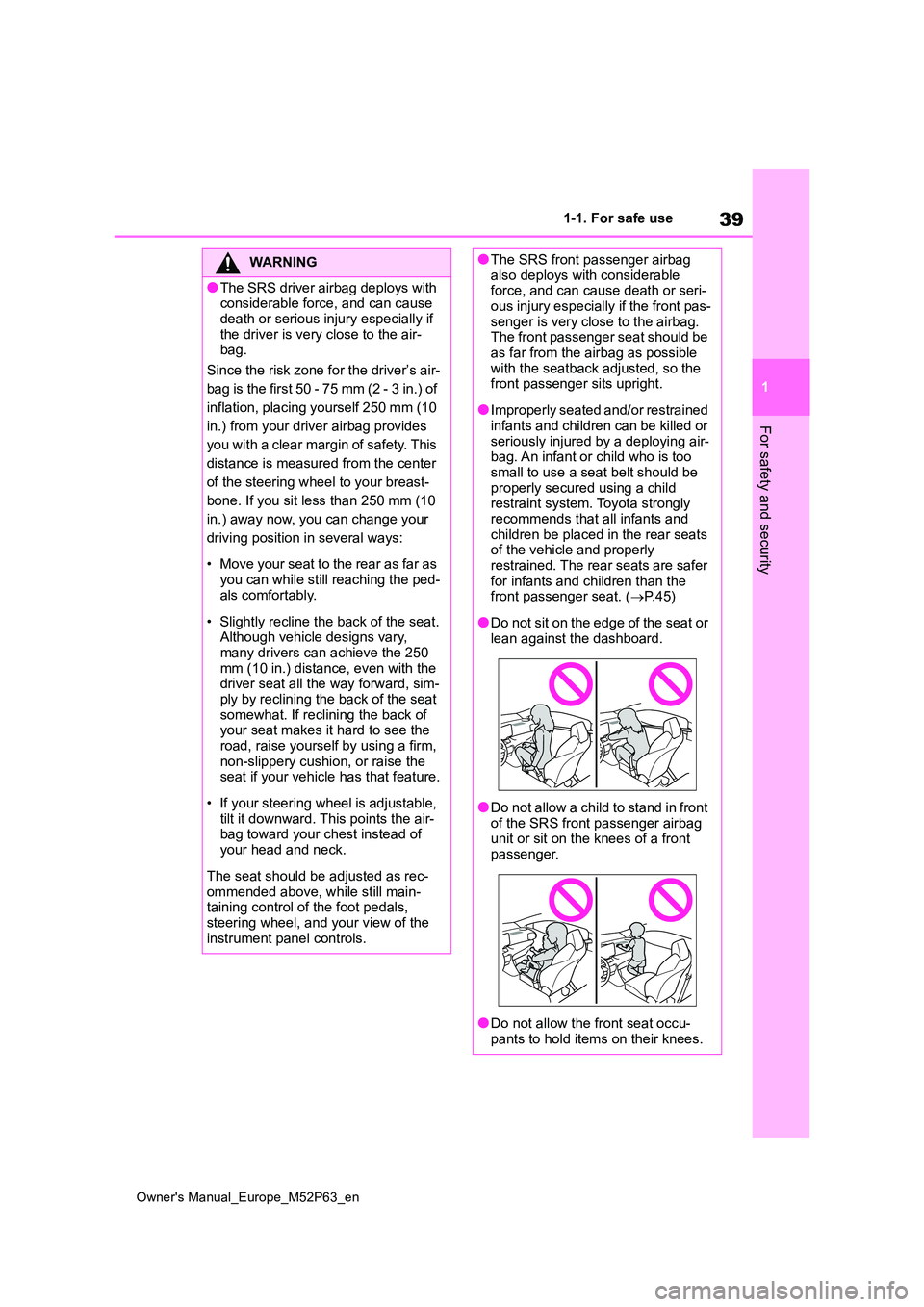
39
1
Owner's Manual_Europe_M52P63_en
1-1. For safe use
For safety and security
WARNING
●The SRS driver airbag deploys with considerable force, and can cause
death or serious injury especially if the driver is very close to the air-bag.
Since the risk zone for the driver’s air-
bag is the first 50 - 75 mm (2 - 3 in.) of
inflation, placing yourself 250 mm (10
in.) from your driver airbag provides
you with a clear margin of safety. This
distance is measured from the center
of the steering wheel to your breast-
bone. If you sit less than 250 mm (10
in.) away now, you can change your
driving position in several ways:
• Move your seat to the rear as far as
you can while still reaching the ped- als comfortably.
• Slightly recline the back of the seat. Although vehicle designs vary, many drivers can achieve the 250
mm (10 in.) distance, even with the driver seat all the way forward, sim-ply by reclining the back of the seat
somewhat. If reclining the back of your seat makes it hard to see the road, raise yourself by using a firm,
non-slippery cushion, or raise the seat if your vehicle has that feature.
• If your steering wheel is adjustable, tilt it downward. This points the air-bag toward your chest instead of
your head and neck.
The seat should be adjusted as rec-
ommended above, while still main- taining control of the foot pedals, steering wheel, and your view of the
instrument panel controls.
●The SRS front passenger airbag also deploys with considerable force, and can cause death or seri-
ous injury especially if the front pas- senger is very close to the airbag. The front passenger seat should be
as far from the airbag as possible with the seatback adjusted, so the front passenger sits upright.
●Improperly seated and/or restrained infants and children can be killed or
seriously injured by a deploying air- bag. An infant or child who is too small to use a seat belt should be
properly secured using a child restraint system. Toyota strongly recommends that all infants and
children be placed in the rear seats of the vehicle and properly restrained. The rear seats are safer
for infants and children than the front passenger seat. ( P. 4 5 )
●Do not sit on the edge of the seat or lean against the dashboard.
●Do not allow a child to stand in front of the SRS front passenger airbag unit or sit on the knees of a front
passenger.
●Do not allow the front seat occu-
pants to hold items on their knees.